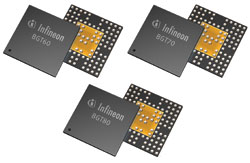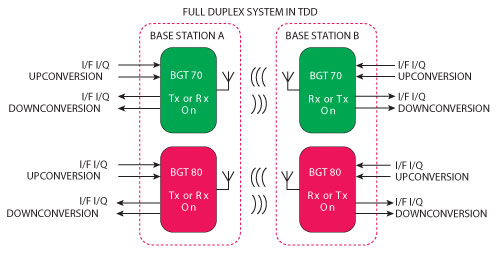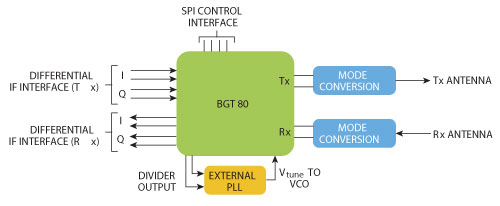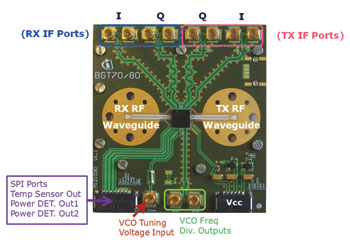
Infineon Technologies AG has introduced a new transceiver family that simplifies system design and production logistics. Due to their low power consumption the single-chip high-integration transceivers also help to reduce fixed costs in high data rate millimeter-wave wireless backhaul communication systems. The new transceivers address the market for wireless data links with data rates of more than 1 Gbps between LTE/4G base stations and core networks.
Mobile communications and especially LTE is gaining momentum due to the fact that all big carriers and mobile phone manufacturers are investing in the 4th generation ecosystem. The challenge that the ecosystem will face is that LTE will further enhance the video and data exchange to a maximum and the bulk of today’s base station infrastructure is not ready to support the required high data throughput. Up until now the connection between the base station has been planned for lower data rates (a few 100 MBit/s) and now needs increased capacity.
This is where the wireless backhaul technology comes into place. A solution using wireless backhaul in the E-Band (71 to 76 and 81 to 86 GHz) will open up a 10 GHz frequency range and in the V-Band (57 to 64 GHz) will open up a 7 GHz frequency range to do so. This enables data rates >1 Gbit/s for video and data services, sufficient for LTE.

Figure 1 E-Band TDD using BGT70 and BGT80 chipsets.
a complete family
To address this issue Infineon has developed a complete family of packaged RF transceivers for mobile backhaul – the BGT70 and BGT80 for E-Band radio and the BGT60 for V-Band radio. Figure 1 shows E-Band TDD using BGT70 and BGT80 chipsets. The modular approach supports the three backhaul frequency ranges of 60, 70 and 80 GHz with one common architecture. Customers can easily design all three radio versions with the same RF footprint as the package is the same for all three transceivers.
Due to the advanced SiGe technology with a transit frequency of 200 GHz, all relevant RF building blocks can be integrated into a single chip. Chips in the Infineon BGTx0 product family come in a standard plastic package (eWLB, embedded wafer level ball grid array). The highly integrated RF transceivers require no external RF discretes, thereby simplifying the customer design and time-to-market. They replace more than 10 discrete devices used in current system designs with one single chip. The customers’ assembly process is simplified dramatically as they can continue to use a standard SMT assembly flow.
The BGTx0 family provides a complete RF front end for wireless communication in 57 to 64 GHz (BGT60), 71 to 76 GHz (BGT70), or 81 to 86 GHz (BGT80) millimeter-wave bands. BGT60 has identical pinning and the same footprint as the BGT70 and the BGT80. Paired with a baseband/modem, the system solution requires less space, offers improved reliability and lower cost for the critical wireless backhaul links needed in mobile base stations that support LTE/4G networks.

Figure 2 Application diagram using the BGTx0 family.
INTEGRATION
The BGTx0 transceivers integrate all of the RF building blocks – I/Q modulator, voltage controlled oscillator (VCO), power amplifier (PA), low noise amplifier (LNA), programmable gain amplifier (PGA), SPI control interface and more – on a single chip in a compact, plastic eWLB package (6 × 6 mm). Validation and calibration of RF performance occurs in production using Built-In-Test-Equipment (BITE), which contributes to the simplicity of integrating the chip into a device builder’s production flow and delivers ‘known good-die’ to the customer. Figure 2 is an application diagram using the BGTx0 family.

Figure 3 Evaluation board supporting the BGTx0 family.
The V-Band and E-Band microwave frequencies available for LTE/4G backhaul support data rates three times higher than in earlier generation networks. Correspondingly they need superior RF performance to meet operating requirements. The outstanding RF performance of the BGTx0 family based on SiGe technology – such as deliverable output power of up to 18 dBm from the PA, low noise figure of 6 dB from the LNA and excellent VCO phase noise of better than -85 dBc/Hz at 100 kHz offset – allows system designers to implement high modulation schemes up to QAM64 with a sample rate of 500 Msymbol and QAM32 with 1 Gsymbol at a 10-6 Bit Error Rate (BER).
Electrostatic Discharge (ESD) performance of more than 1 kV increases the robustness and eases the system design for customers. The low power consumption of less than 2 W for this backhaul transceiver family also allows network operators to reduce related fixed expenses. Due to the direct conversion architecture of the transceiver, the interface between RF and baseband is simplified significantly compared to currently available discrete millimeter-wave systems.
The technology used is already proven and fully qualified for Infineon millimeter and microwave chipsets (e.g. 77 and 24 GHz automotive radar). Furthermore the offering of these single chip solutions in a plastic package makes a major difference to the market. Up until now, solutions have been bare die and require expensive tools and equipment to build up a radio system. With the packaged chipset, customers can save money and reduce the time-to-market significantly. Engineering samples and evaluation boards (see Figure 3) of the BTGx0 family will be available by the end of September 2013, with production ramp-up planned for early 2014.
Infineon Technologies, Neubiberg, Germany
+49 (89) 234 24984,
www.infineon.com
